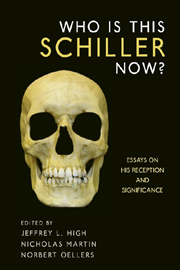Book contents
- Frontmatter
- Contents
- Foreword
- Acknowledgments
- List of Abbreviations
- Introduction: Why Is This Schiller [Still] in the United States?
- Part I Schiller, Drama, and Poetry
- Part II Schiller, Aesthetics, and Philosophy
- Part III Schiller, History, and Politics
- Part IV Schiller Reception — Reception and Schiller
- 17 Schiller and the Gothic — Reception and Reality
- 18 Schiller's Plays on the British Stage, 1797–1825
- 19 From Martyr to Vampire: The Figure of Mary Stuart in Drama from Vondel to Swinburne
- 20 A Chapter of Schiller in America: The First World War and Volume 3 of Kuno Francke's Edition of The German Classics
- 21 The Reluctant Recruit? Schiller in the Trenches, 1914–1918
- 22 Schiller — Kommerell — George. Eine Konstellation der Moderne
- 23 Was sagte dieser Schiller (damals)? Schillers Antworten auf seine Kritiker nach 1945
- Part V Schiller Now
- Notes on the Contributors
- Index
17 - Schiller and the Gothic — Reception and Reality
from Part IV - Schiller Reception — Reception and Schiller
Published online by Cambridge University Press: 05 February 2013
- Frontmatter
- Contents
- Foreword
- Acknowledgments
- List of Abbreviations
- Introduction: Why Is This Schiller [Still] in the United States?
- Part I Schiller, Drama, and Poetry
- Part II Schiller, Aesthetics, and Philosophy
- Part III Schiller, History, and Politics
- Part IV Schiller Reception — Reception and Schiller
- 17 Schiller and the Gothic — Reception and Reality
- 18 Schiller's Plays on the British Stage, 1797–1825
- 19 From Martyr to Vampire: The Figure of Mary Stuart in Drama from Vondel to Swinburne
- 20 A Chapter of Schiller in America: The First World War and Volume 3 of Kuno Francke's Edition of The German Classics
- 21 The Reluctant Recruit? Schiller in the Trenches, 1914–1918
- 22 Schiller — Kommerell — George. Eine Konstellation der Moderne
- 23 Was sagte dieser Schiller (damals)? Schillers Antworten auf seine Kritiker nach 1945
- Part V Schiller Now
- Notes on the Contributors
- Index
Summary
Schiller's stature as a pioneering author of Gothic literature, though long since established in Gothic Studies, and reaffirmed with every new critical companion to that genre, has failed most conspicuously to attract the notice of Germanist scholars. This apparent oversight can be accounted for in large part by the view of the “Gothic” traditionally cherished among Germanists as an inherently and uniquely British phenomenon. (The equally traditional view of the “Gothic” as Trivialliteratur offered little inducement to impugn a luminary like Schiller with an association to that mode of writing.) The lack of Germanist participation in examinations of Schiller's connection to the Gothic has resulted not only in a body of scholarship in Gothic Studies that all too frequently betrays its limited grasp of Schiller's oeuvre and native tongue, but in a series of missed opportunities for students of his work to recognize fully the Gothic's influence on his own literary writings.
SCHILLER'S RELATIONSHIP TO GOTHIC LITERATURE is as much a matter of perspective as it is of literary history. In Gothic Studies, a putatively international field that remains nonetheless dominated by English letters, Schiller's status as an influential Gothic writer has long been established. After the ubiquitous E. T. A. Hoffmann, he is the most widely cited German author in reference and companion volumes to the Gothic. In Germanist scholarship, on the other hand, contributions made to the Gothic canon have never been ranked very highly — or even at all — among Schiller's accomplishments.
- Type
- Chapter
- Information
- Who Is This Schiller Now?Essays on his Reception and Significance, pp. 287 - 301Publisher: Boydell & BrewerPrint publication year: 2011

